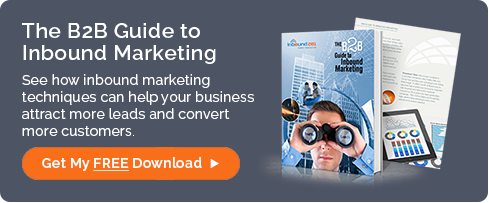What You Absolutely Have to Know About Inbound Marketing
Modern marketing techniques are complex and sometimes difficult to understand, but they work. In most cases, the word "modern" translates to...

The human brain is an amazing organ.
In 2014, a team of neuroscientists from MIT found that the human brain can process entire images seen by the eye in as little as 13 milliseconds.
Now think about all the other data and information that people are picking up and processing with their other senses, and the sheer volume of material being processed during any one point in time is staggering.
That is what you are competing with as a marketer.

People are inundated with all kinds of sights, sounds and other information every second of the day. Personalized inbound marketing solutions can help cut through the noise and connect with them. ![]()
So what is the brain doing with all this information? It is sorting it according to relevance by means of a handy processor called the reticular activating system (RAS) which filters and prioritizes all incoming information.
It is the RAS that enables you to zero in on someone calling your name in a noisy crowd of people, or to notice or ignore the brake lights of a car pulling out of a parking space two blocks away (dependent on whether or not you need a place to park).
What does all of this have to do with marketing? Understanding how the human brain processes information by ranking its relative importance should tell you something about your marketing strategy.
Basically, if you want your marketing message to take priority over all the noise of your competitors, you must make it personal and relevant to your target audience. In other words, you must tailor your message in such a way that it is noticed, ranked as important by that RAS, and given top priority with your audience.
In the age of digital marketing, personalization converts. Harvard Business Review's "How Marketers Can Personalize to Scale" notes that personalization can deliver five to eight times the ROI on marketing spend, and can lift sales by 10 percent or more.
Aseem Chandra, vice president of Adobe Experience Manager and Adobe Target for Adobe's Digital Marketing business notes in the Forbes article "Why Personalization is Key to the Future of Marketing":
"It's clear consumers are increasingly demanding more personalized and customized service in the digital as well as physical worlds. A mobile-optimized website or salesperson wielding an iPad are table stakes now, and as marketers we need to anticipate expectations with new ideas and inspirations of our own."
In order to leverage the power of personalization, some basic, foundational information is necessary. Just as a tailor takes specific measurements of his or her client to ensure a proper fit, so too, marketers seeking to personalize their message must take a measure of their clients.

Personalization is about tailoring your message until it is the perfect fit for your audience. ![]()
Mine your database to find out all you can about your target audience. Learning things like which social media platforms they prefer, when they are likely to be online, and how they normally interact with your brand will help you begin the personalization process.
Once you have this information, you can segment your marketing message to more closely coincide with buyer personas. For instance, personalization may be something as simple as timing your emails to be sent at a time when your audience is likely to be online.
Personalization can also include triggering automated responses to various customer interactions. For instance, you might offer a tutorial about how to use a specific product when a potential customer lingers on the product page. Perhaps you could trigger an automatic reminder of previous interest in your product or service with an automated email within a designated time after a potential customer leaves your website.
These are simple examples of personalization, but today's digital technology enables marketers to dig much deeper into customer behaviors, rooting out the things that make each customer tick.
Are you wondering how you can build and deliver content your target audience will want to read? Start by building personas to get a better understanding of what your best customers are interested in. For more help, check out our blog article "Buyer personas: What are they and why does your business need them?"
An inbound marketing approach can help your brand more effectively stand out in the crowd and deliver the personalized messages that will resonate with your customers. Get your free copy of our B2B Guide to Inbound Marketing to learn more about launching your inbound plan.

Make sure to connect with us on LinkedIn to get valuable insight on the latest news in marketing and website design. Follow us here:

Modern marketing techniques are complex and sometimes difficult to understand, but they work. In most cases, the word "modern" translates to...

Video marketing continues to evolve, and staying ahead is crucial. In 2025, emerging platforms and innovative strategies will reshape how brands...

Over the past several years, Google and marketers have experienced something of a love-hate relationship. While Google's advertising opportunities...